The Dolomites – the Alpine subregion along the border of Italy and Switzerland – have some of the most dramatic beauty of any mountain range in the world. Here, jagged peaks create a stark landscape that is by turns spectacular and desolate. When contrasted with the surrounding pristine glacial lakes and rich pine forests, the mountains offer up simply stunning photos. Whether you’re a professional photographer or simply looking to capture the region’s beauty on your iPhone, this guide highlights the best Dolomites photo spots to ensure you “get the shot.”
Jump to:
- Tre Cime di Lavaredo
- Val di Funes and Santa Maddalena Church
- Seceda Ridgeline
- Lago di Braies
- Alpe di Siusi
- Lago di Carezza
- Lago di Sorapis
- Cadini di Misurina
Tre Cime di Lavaredo
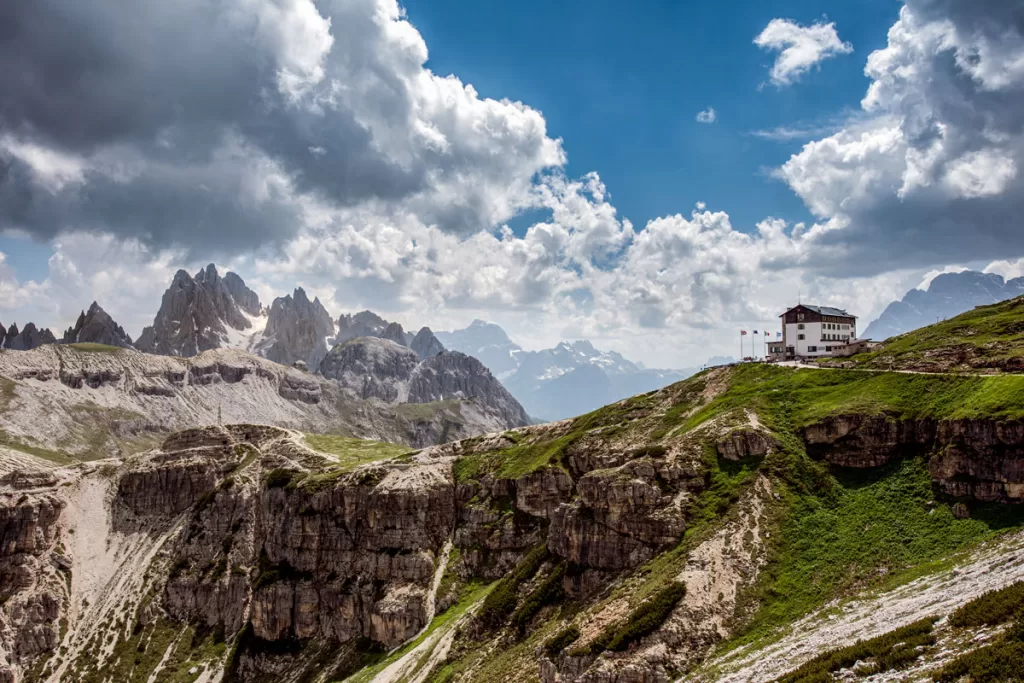
The “three peaks of Lavaredo” are one of the most famous Dolomites photo spots, and have even been designated a UNESCO World Heritage Site. The trifecta of distinct spikes rise like spires above the ridgeline surrounding them.
It’s a short hike from the parking lot trailhead (directions) to the iconic viewpoint, but there are also 10km of surrounding trails, for additional vantage points and other interest points. The nearby rifugi and whimsical Cappella degli Alpini chapel all provide a human element to the otherwise wild, windswept mountains.
Note: beginning in 2025, you must make an online reservation to park at the Tre Cime di Lavaredo parking lot. Once the daily quota has been reached, no more vehicles will be permitted up the access road. You can learn more and make a parking reservation here.
When to Go: with so many angles, you can utilize the lighting at different times of day for different photos. Our photos here (as shown) were taken in later afternoon. However, note that parking availability can get extremely limited as the day progresses – for that reason, you may want to opt for early morning to beat the crowds.
Photo Tip: give yourself time to hike the connecting footpaths. The resulting photos will tell a much larger story than just the famous Tre Cime image alone.
Val di Funes and Santa Maddalena Church

You’ve most likely seen the dreamy images of Val di Funes. It’s one of the most iconic Dolomites photo spots, with tiny Santa Maddalena nestled into the verdant valley beneath soaring mountain peaks.
The valley is located about halfway between Bolzano and Cortina d’Ampezzo. To get the shot, you’ll need to climb above the hamlet of Santa Maddalena itself. The shortcut is to take the small local road the winds upwards out of town (viewpoint directions), or you can park in town and walk one of the many footpaths crisscrossing the hillsides for different angles.
Whichever you choose, your efforts will be rewarded with stunning photos worthy of any glossy travel magazine. (Just be respectful of the locals and any private property!)
When to Go: golden hour (or at least late afternoon) will add a softness to your images.
Photo Tip: bring a zoom lens to amplify the detail of quaint Santa Maddalena, so it isn’t lost among the sweeping landscape beyond.
Seceda Ridgeline
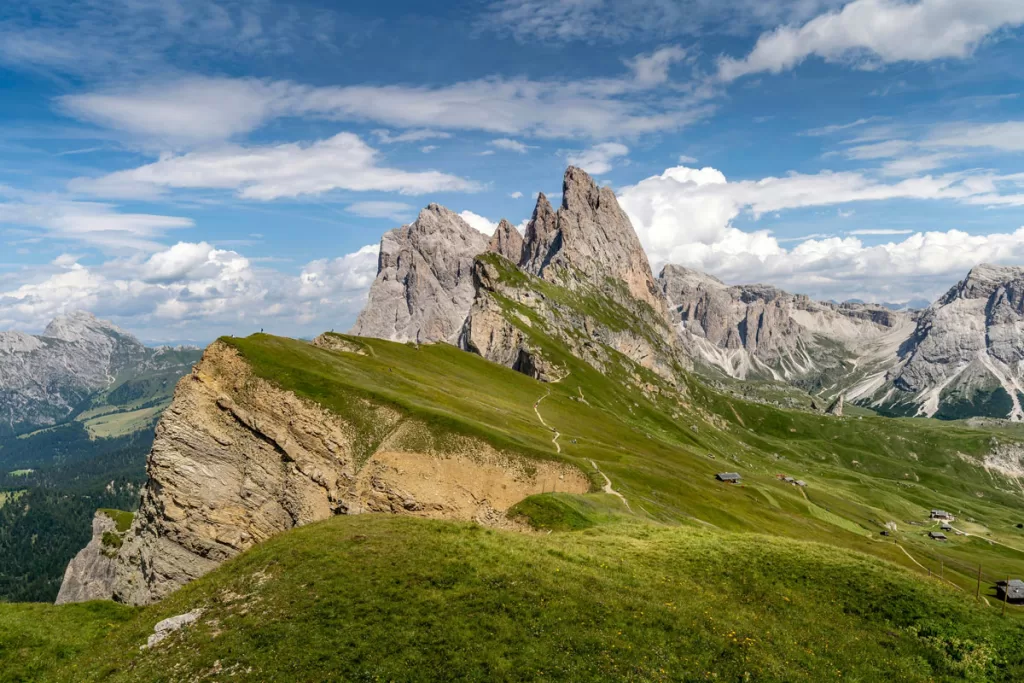
Like something straight out of a Tolkein novel, the knife-edged Seceda ridgeline rises vertically out of the green hillside beneath it to pierce the sky.
To get here, you’ll need to take the Ortisei cable car (directions) to the Furnes transfer stop, continue to the top of the mountain, and walk about 850m uphill to the famous overlook.
When to Go: sunrise. You’ll get the golden light, and avoid the crowds that grow with the day.
Photo Tip: bring your wide-angle lens for the panorama, and a zoom lens to capture the detail of the jagged ridges.
Lago di Braies
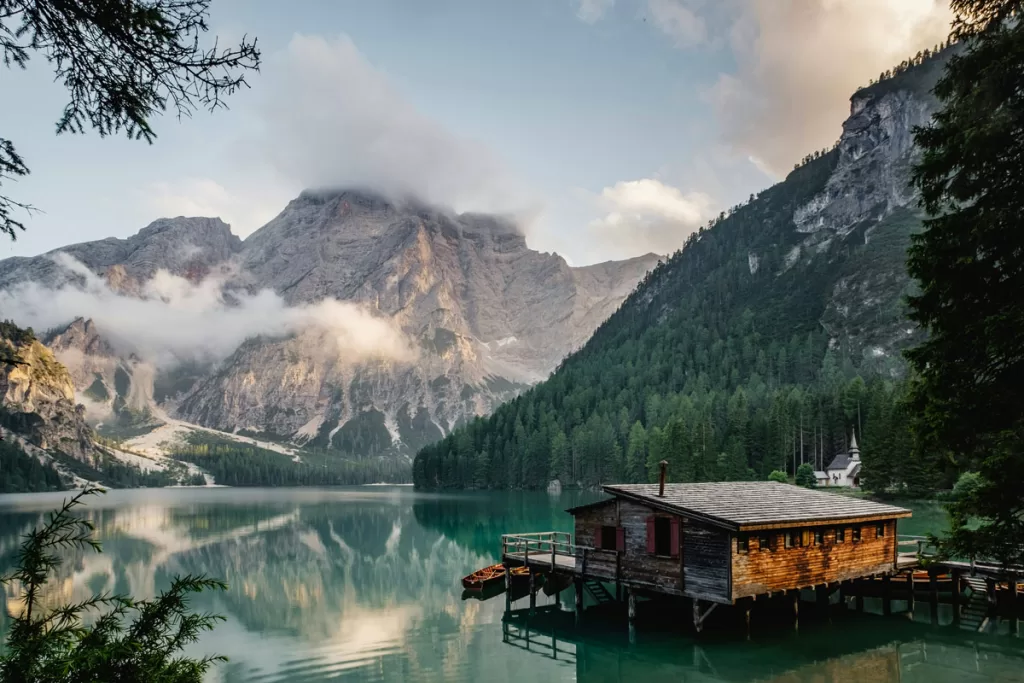
Lago di Braies is one of the most photographed lakes in Italy, with snowcapped peaks rising above sparkling turquoise waters. A small dock on the northern shoreline, with wooden pleasure boats and a solitary boathouse, enhances the perspective. Directions.
When to Go: early morning, for the serenity and stillness of the lake.
Photo Tip: make sure you photograph from the boathouse, to capture the iconic shot. You can also rent a boat for a waterfront perspective.
Alpe di Siusi
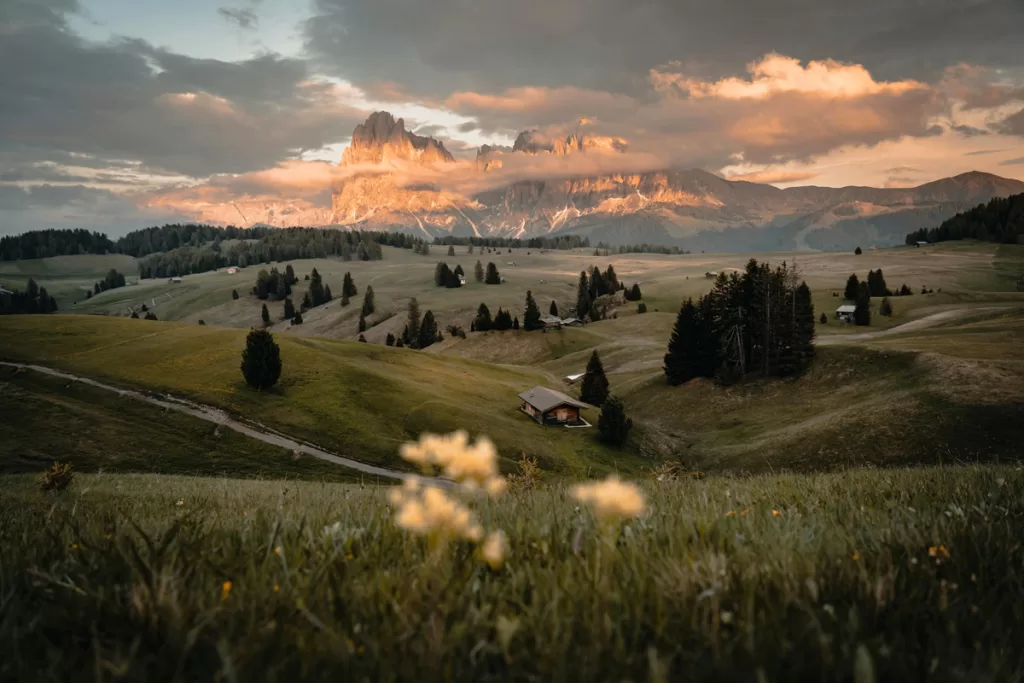
Also known as Seiser Alm (South Tyrol has three official languages, after all), this is the largest Alpine meadow in Europe.
While it lacks the raw drama of sharp Dolomite peaks, the dreamy rolling hills offer some variety to your photos, with an airy, ethereal magic that is heightened in the early morning hours. You can utilize the free car park by the Seiser Alm cable car (directions).
When to Go: sunrise, with the morning mist adding some additional texture, contrast, and overall mood.
Photo Tip: a telephoto lens will compress the small barns dotting the meadow against the distant mountains, for heightened perspective.
Lago di Carezza
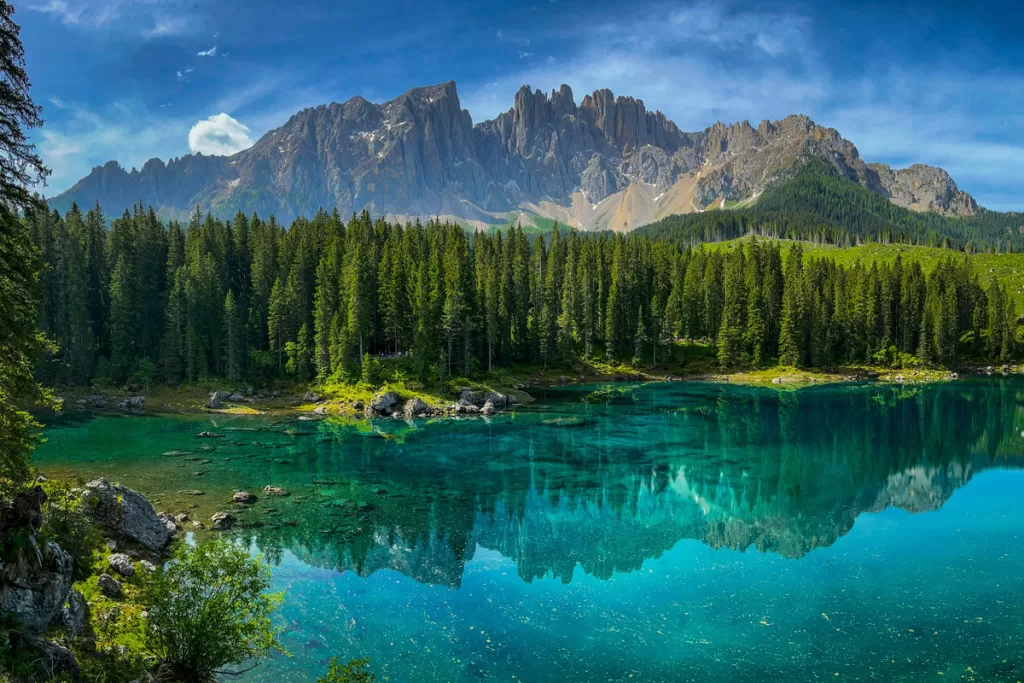
Affectionately nicknamed the “Rainbow Lake,” this small Alpine lake is famous for its sparkling turquoise waters, which often perfectly reflect the Latemar peaks rising behind it.
The lake is right off the SS241 road, making it easily accessible (directions).
When to Go: sunrise or sunset for softer lighting.
Photo Tip: self-evident, but the best photos are from the northern shore, looking out towards the background mountains for contrast.
Lago di Sorapis
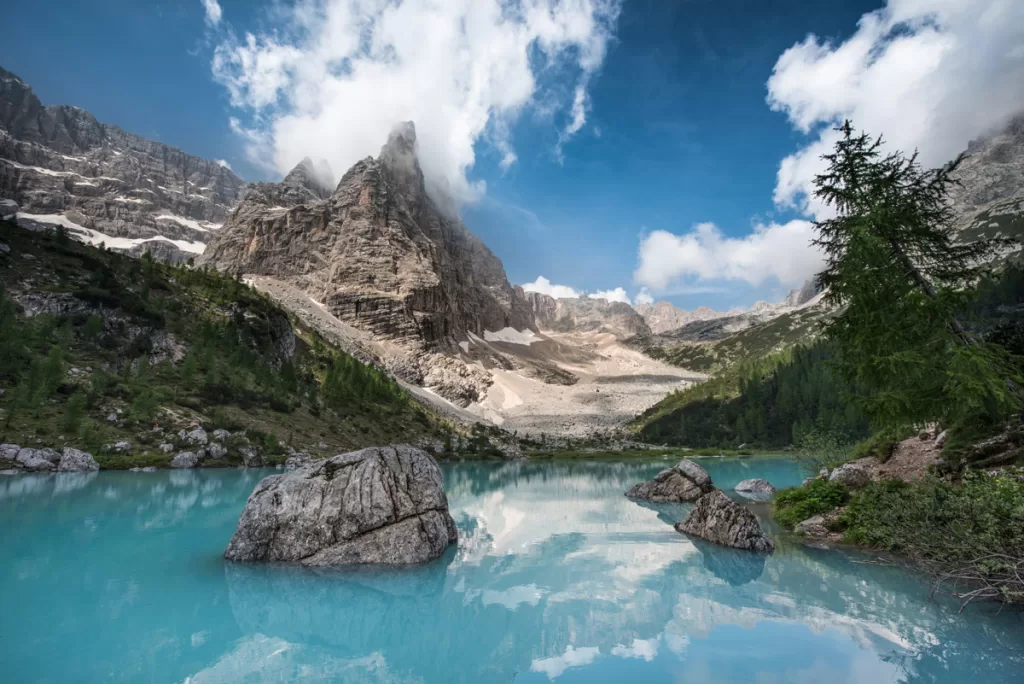
The hike to reach this glacial lake is only for those in decent shape. It’s a challenging 13km roundtrip, with over 600m of elevation gain. However, your reward is a pristine high Alpine lake, with the most otherworldly color you’ve ever seen.
Sorapis’ magical hue comes from the fine silt in the nearby glacier, which is transported via snowmelt into the lake. The result is a brilliant shade of aquamarine, that is both shimmering and opaque at the same time.
The trailhead is along SR48 (directions). You’ll park along the shoulder of the road, and then pick up the trail via a dirt fire road that winds through the valley before beginning the climb.
When to Go: early morning, to minimize the crowds (and maximize the soft morning light). Sorapis’ unique color stands out best on sunny days, so aim for a day with good weather, if you can.
Photo Tip: Most people stop close to where the trail deposits you at the mouth of the lake. However, we recommend venturing further around the shore for additional viewpoints and angles. We got some unique photos by continuing along in a counterclockwise direction from the entry point.
Cadini di Misurina

This hike is not as well-known, but in our opinion it’s one of the most sensational Dolomites photo spots you can find.
The Cadini di Misurina trail itself is brief – just over 3km roundtrip and 200m elevation gain. It departs from the same parking lot as the Tre Cime di Lavaredo (directions), so you can capture both photos in one stop, if you desire.
The trail will lead you to a narrow outcropping that appears almost suspended in air, with the craggy Misurina spikes beyond.
When to Go: As with the Tre Cime di Lavaredo, this same parking lot can get very crowded as the day goes on. While you can take stunning photos at any time of day here, you may want to go early in the morning, solely to avoid the crowds.
Photo Tip: Save this one for a sunny day. Not only do you need the light to fully accentuate the colors of the landscape, but the trail often gets slippery after rain. Not something you want to risk, on such a narrow footpath.
Note: beginning in 2025, you must make an online reservation to park at the Tre Cime di Lavaredo parking lot. Once the daily quota has been reached, no more vehicles will be permitted up the access road. You can learn more and make a parking reservation here.
